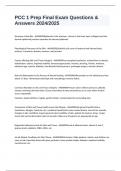PCC 1 Prep Final Exam Questions &
Answers 2024/2025
Structure of the Skin - ANSWERSEpidermis is the top layer , dermis is the inner layer (collagen),and the
dermal-epidermal junction separates the dermis/epidermis
Physiological Processes of the Skin - ANSWERSEpithelial cells cover all external and internal body
surfaces. It protects, absorbs, excretes, and secretes.
Factors affecting Skin and Tissue Integrity - ANSWERSPoor peripheral perfusion, malnutrition or obesity,
dehydration, edema, impaired mobility, immunosuppressants, irritants, shearing, friction, moisture,
advanced age, anemia, diabetes, low diastolic blood pressure, prolonged surgery, vascular disease.
Role of Inflammation in the Process of Wound Healing - ANSWERSInflammation or the initial phase lasts
about 3-5 days. Homeostasis develops and macrophages remove debris.
Common Alteration in skin and Tissue integrity - ANSWERSPressure ulcers: Relieve pressure, debride,
cleanse, and keep skin bed moist. Occurs most often at bony prominences or an area where friction
occurs repeatedly.
Incisions: staples/stitches, irrigate, gentle friction, contaminated to surrounding skin.
Assessment of Skin and Tissue Health across the lifespan - ANSWERSAsk general health history
(medicines, allergies, family hx, etc.), problem based history (new rashes/lesions, loss of hair, wounds,
changes in skin condition), inspect general color/condition of skin, palpate for texture, temp., turgor.
Assess the size/location/odor/color of wounds. Make sure all aspects are appropriate to age.
Diagnostic/Laboratory tests for Skin and Tissue - ANSWERSLook at albumin levels, vitamin A and C,
glucose levels, platelets, WBCs, RBCs, etc.
At-risk Patient Conditions for Skin/Tissue - ANSWERSRisk factors: Older patients, infants, and children are
more at risk. Especially those with poor perfusion, lower protein intake, diabetes, impaired mobility,
incontinence, etc.
, Nursing Interventions for Skin and Tissue health - ANSWERS• Interventions: pharmacotherapy
(antibiotics, steroids, etc.), wound care, nutritional support, surgical support (skin grafts, excisions,
debridement)
Prevention of alterations in skin and tissue integrity - ANSWERSPrevention: MOBILIZE! Use different
positions, pillows, offset. Move q2hrs, use specialty beds, lift sheets, cleanse skin if incontinent, remove
excess moisture
Nursing Processes with common alterations in skin and tissue integrity - ANSWERSMake sure patient
understands how to care for wound (if older, show that they can demonstrate, if younger, make sure
parents can). Show proper preventatives for how they can protect skin. Different nutrients they need.
Staging of pressure ulcers - ANSWERS• Stage 1: intact skin with nonblanchable redness • Stage 2: Partial
thickness loss of dermis, shallow open ulcer • Stage 3: Full-thickness skin loss, SQ may be visible • Stage
4: Full-thickness loss, can extend to muscle, bone, tendon
Care of wounds/dressings/drainage - ANSWERSLook at interventions (pharmacotherapy, nutrition,
surgical support) • Dressings: gauze, occlusive, vacuumassisted, transparent film, foam, hydrogel,
packing, etc. • Drainage: constant, low-pressure vacuum to remove/collect drainage, could use suction,
negative pressure, etc.
Preventative skin care - ANSWERSMOBILIZE! Use different positions, pillows, offset. Move q2hrs, use
specialty beds, lift sheets, cleanse skin if incontinent, remove excess moisture
Skin assessment/tools - ANSWERSInspection, palpation, history.
• Braden Scale, wound stages, etc.
• Serous: light pink
• Serosanguinous: water blood
• Sanguineous: Blood
Types of wound healing - ANSWERSPrimary Intention: edges well approximated, most rapid healing
• Secondary Intention: have to fill wound in, gapes a bit




